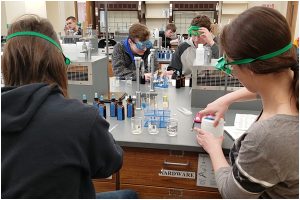07 Feb How Dickinson State University’s Natural Sciences’ programs have responded to STEM workforce development needs
By: Dr. Craig Whippo, Associate Professor of Biology and Co-Chair of the Department of Natural Sciences & Dr. Corinne Brevik, Professor of Physics and Co-Chair of the Department of Natural Sciences
 Students today can learn content at a distance from online written materials, videos and self-paced exercises. The need for asynchronously delivered online educational opportunities to teach content will continue to grow. On the other hand, critical thinking skills and the ability to apply knowledge in a real-world setting must be practiced in a face-to-face, hands-on environment. The most effective and lasting way to learn these skills is through live interactions with a teacher who also serves as a mentor outside of class. Active faculty-student interactions improve academic progress, student persistence, educational attainment and institutional retention rates. These faculty-student interactions have always been a hallmark of Dickinson State University’s (DSU) Department of Natural Sciences. We hear DSU Natural Sciences alumni often reflect upon the importance of the relationships that they built with professors such as Myron Freeman, Robert Todd, or Paula Martin in their intellectual development. The current faculty of the Department of Natural Sciences continues to follow these footsteps in innovative ways.
Students today can learn content at a distance from online written materials, videos and self-paced exercises. The need for asynchronously delivered online educational opportunities to teach content will continue to grow. On the other hand, critical thinking skills and the ability to apply knowledge in a real-world setting must be practiced in a face-to-face, hands-on environment. The most effective and lasting way to learn these skills is through live interactions with a teacher who also serves as a mentor outside of class. Active faculty-student interactions improve academic progress, student persistence, educational attainment and institutional retention rates. These faculty-student interactions have always been a hallmark of Dickinson State University’s (DSU) Department of Natural Sciences. We hear DSU Natural Sciences alumni often reflect upon the importance of the relationships that they built with professors such as Myron Freeman, Robert Todd, or Paula Martin in their intellectual development. The current faculty of the Department of Natural Sciences continues to follow these footsteps in innovative ways.
These innovations began several years ago when our science programs refocused their student learning objectives on the process of doing, communicating and evaluating science. This refocusing represents a departure from traditional undergraduate science learning objectives that emphasized the memorization of specific details and rote problem-solving. The old paradigm of science education incorrectly assumed that strong memorization skills indicated a student’s level of intelligence. In today’s society, the ability to think critically and creatively is more important than rote memorization skills because nearly everyone has access to online information on their smartphones. The traditional focus on rote learning can cause capable students to fall behind and “weeds” them out of the STEM training pipeline. Consequently, many students who start out as STEM majors drop out of college or switch majors.
To improve student success in our introductory courses for majors, we have moved away from passive lectures to a mixture of lectures and active learning. In the introductory biology sequence, for example, students learn the core concepts by interacting with real scientific data to construct an understanding of a concept based on evidence. By approaching science through evidence, introductory biology students learn science in the way that practicing scientists learn new concepts – in the context of data. We have found that this approach decreases the gap between struggling students and thriving students while increasing overall rigor. Students also engage in the material more deeply and learn to think like advanced scientists earlier in their career. Prior to making these changes, 30 to 50% of students enrolled in introductory science courses would be academically unsuccessful. After making these adjustments, the percentage of unsuccessful students decreased to 5 to 15%. These changes have improved our student retention rates, and we are seeing more students taking biology courses or picking up biology majors and minors. An added benefit of these changes is that these courses are more enjoyable for the faculty because it is fun and rewarding to see students make the connections on their own.
We have also improved access to formal mentoring opportunities for our science majors because educational research indicates that faculty-student mentoring relationships improve degree completion rates, enhance opportunities for underrepresented groups, and increase participation in the STEM workforce. One way that we have improved mentoring opportunities for our students is through the institution of a capstone research experience for all science majors. This research experience starts with a student choosing a faculty-research mentor in their junior year and writing a formal research proposal outlining the research goals, expectations and methodology. Before starting their research, the students are required to present their proposal and defend it to a panel of faculty members. The process of defending their proposal gives students experience making persuasive arguments and helps prepare them for similar defenses required for advanced degrees. Next, during the fall semester of their senior year, students perform the research that they proposed, and they learn how to analyze the data that they generate. Once the data is collected and analyzed, students write a formal scientific manuscript about their research project and give presentations to the public about their research. The mentoring students receive from faculty in this process is unique because all of our students are given this opportunity, unlike other universities where undergraduate research experience is reserved for honors students alone.
Our faculty interactions with students can be characterized by more than what happens in our classrooms or research settings. Because we are a small community, the students encounter our faculty many times over the course of their undergraduate career in a wide variety of situations. This allows faculty to relate to each student individually and to demonstrate an interest in the immediate and long-term goals of our students. When a student needs a little more motivation and encouragement, we are able to respond in targeted ways to help students stay on track. We understand that many of our students will be the first in their family to graduate from college. While family support is essential to academic success, our faculty help fill in the gaps on topics related to specific academic requirements and career guidance. As students prepare to graduate, our faculty help students by reviewing graduate school and job applications as well as personal statements. We also write letters of recommendation that are based upon our intensive interactions with students. Because these letters of recommendation are specifically tailored, we can highlight aspects of our students’ skills and abilities that are not always evident in an academic transcript. These types of interactions are essential for student success in transitioning from an undergraduate university to a professional school or straight into a career.
One of the goals of DSU’s science department is to build a competent and flexible STEM workforce. North Dakota proudly ranks sixth in the country in terms of the percentage of adults who have graduated from high school (92.3%). However, we only rank 28th in the number of these individuals holding a bachelor’s degree (28.9%), and we rank last in the proportion of adults with advanced degrees (7.8%). These statistics suggest that North Dakota universities and colleges have work to do to improve adult access to meaningful educational opportunities because the state needs to develop a workforce that is thoughtful, creative, precise, resilient, and diversified in order to thrive in an age of rapid changes. Obviously, not all careers require these traits, but large corporations consider these workforce traits when deciding where to locate their operations. Furthermore, North Dakota’s largest employers include health care, education and scientific services. In these fields, STEM degrees are often required, and revenue generation is heavily dependent upon workers’ skills and knowledge. By being more deliberate in our approach to establish and grow strong student-faculty relationships, DSU’s science faculty are helping to build and grow the desperately-needed STEM workforce in western North Dakota.


